

Karsnoyarsk 56.2° N 92.5°E
9:10 p.m. Local Siberia; 9:10 a.m. next day EST
High 69F Low 42F Rain
We are back to where we started – in comfortable rooms at the Hotel for Scientists in Krasnoyarsk. We drove through the night and arrived here about 6:15 this morning. Even at that early hour, we were graciously greeted us and received keys to our rooms right away. After twenty two hours in the car, everyone was ready for a rest. So that’s what the day has been – a day of rest.
The ride home from camp went a lot smoother than the ride out. There was no car trouble at all. The Gorilla Glue on the windshield held up nicely, even at highway speed. All we had to do was gas up and drive. I think that the UAZ was kind of like an old horse ready to get back to the barn – it was a real quick ride.

All the Americans hung out at the hotel today. I slept until about 11 am, and then got a bite to eat. I feel pretty good, for only have slept about four hours in the last 48. There’s television here and I watched some of that. I don’t understand the language, but that’s okay – television is still entertaining.
After television, I thought I’d get on the internet and check in, to see what’s been going on in the world and catch up with work a bit. That was a struggle. I spent two hours trying to get a signal. I have it now, but it’s not that great, so I’m not well connected with the world.
Ross and Bruce and I also got together to talk about the trip, how things went, and discuss what could go better in the future. I guess you could call it a “hot wash”, but we just called it hanging out and talking. It’s a useful thing to do on a quiet day.
When I got in last night, I wanted to wash my face. I turned on the hot water faucet, wondering if the repairs to the system would be done, and if there would be any heat, or if it would be ice cold. It was not really either. The water was very slightly warm – slightly less than tepid, really. I was too tired for a cold shower, so I just toweled off quickly and went to bed, with the hope that the slight touch of warmth meant that repairs had been finished and that things would be better soon.
Sure enough, by this afternoon the hot water had been restored. What a treat! It’s always so nice to have a long, hot shower after expedition. On the other hand, a cold shower can feel really brutal when you’re so weary. I guess we are spoiled in America. We expect warm water all the time, on demand, at the turn of a faucet. But I can tell you from experience, that’s just not the case in many places. Warm water is a wonderful luxury.
I think I’ve always been in Krasnoyarsk when the hot water has been turned off. It seems that every expedition has been like this – no hot water either at the beginning or the end. We’ve never had to have cold water on both ends, however. Just the start or the end. It must take the government a week or so to make the repairs and perform maintenance, then they turn the water back on. I don’t know if the dates are scheduled in advance, so the locals know when they are going to get cold. But we never know before we get here. We just take whatever comes.
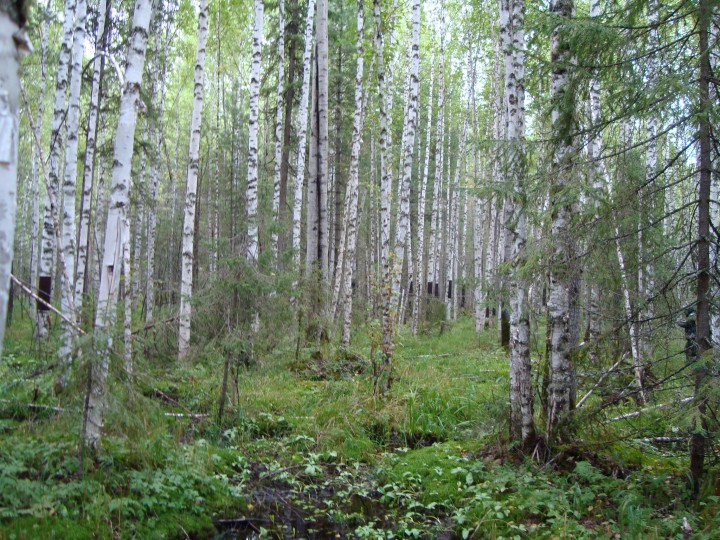
This is a pretty decent hotel, and it caters to foreigners with money. When the hot water is turned off, someone with money can still get a warm shower. The hotel has a private shower downstairs, with an on-demand electrically heated private hot water system. So it’s possible to get warm water, but you do have to pay extra for it. I’ve tried it before, and it’s not that wonderful. It’s just a trickle of water coming out of a wand-like thing so that you can run the water all over your body. For an American, it’s really a pretty sad shower. But, here, hot water is truly prized, and I’m sure it’s worth every ruble.
The plan from here is to get up tomorrow and go meet our Russian colleagues at the Sukachev Institute of Forest. We’ll talk about the trip, make sure everyone had the data they need, and wrap up the expedition. We’ll try to go out for a dinner together, to say good bye for this year. Then, the next morning, we’ll catch a flight from Krasnoyarsk to Moscow, then one to home. The Wild West Expedition of 2010 is just about complete.
It is early here, but the sun is down and a full moon has come up. I guess the Northern pike will be biting, for anyone willing to go to the river, since their new teeth should be in by this full moon. For me, it’s too far to go for fish soup. The pike can safely enjoy the moonlight and try their teeth on natural things, not lures. I’m still tired from the long ride, and ready to turn in for the night. Maybe another trip, in another year, we’ll meet the big pike with the fresh teeth.
Marinsk, 56.22 N 87.75 E
12:00 midnight Local Siberia; 12:00 Noon next day EST
High 74 F Low 69 F Rain
Today has been one long day of travel – and our day is not over yet. I’m calling from a little café in Marinsk, which is a town about 200 km east of Tomsk. It’s in the Kemerova Oblast and they tell me it sits the Kiya River. The drivers are buying big cups of coffee. Even though it is late and it is raining, our drivers say they still feel fresh and don’t want to quit. Our goal tonight is the Hotel for Scientists, in Krasnoyarsk.
We had planned to stop and camp for the night, but the sun set and rain started pouring down. It just didn’t make sense to go find a camp down a bad road in soaking rain, just to sleep for a few hours. We would have ended up soaked and cold. We decided it would be smarter to find a room for the night in one of the big towns, but that hasn’t worked out. Now we are only about 5 hours away from a real bed at our hotel. Our drivers are well-caffeinated and excited to drive on – so that’s fine with me. I just hope that the Hotel will be open and have our rooms ready at five in the morning, when we arrive.
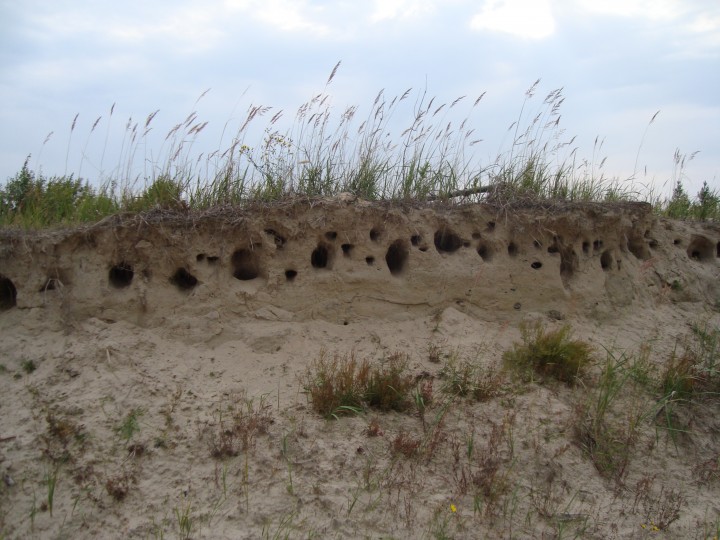
As we left our camp this morning, I discovered something pretty interesting. Next to the road there was a small sandy cliff, no more than three or four feet high. It had a bit of grass on top, but the face of the cliff was all packed sand. And the cliff was riddled with holes. I think cliff swallows are nesting here.
Slava confirmed that birds have used those nests, but he says they do not have pointed tails, like swallows do. I don’t have a bird book with me, but I think cliff swallows have less pointed tails than others. I’ll have to check this out when I get home. At any rate, the nests are right at eye level, and I went up to take a close look. No birds were to be seen. I guess they have finished nesting for the summer and have moved on. A sign of the winter that will soon be coming, no doubt.
Another sign of the times was the sunset last night. It was colorful, but it was as hazy as I’ve ever seen the sky in Siberia. Then when the moon came out, it looked veiled, too. It was almost full and it was bright, but the sky wasn’t clear. I believe we are seeing the effects of the smoke from all the fires that have been burning to our west. I can’t smell anything, and the air on our faces seems fresh enough. But haze from fires can travel high into the atmosphere, and travel across the world. So I think that is what we are seeing – a smoky Moon from those Russian fires.
I also learned that the camp we had last night had been used by geologists in years past. They were studying the area for oil and gas. So it’s all about using natural resources. The geologists will use resources in a different way than the people who collect birch bark, or the timber industry – or us, too, for that matter. We’re using natural resources, too, just in a different way. But our way also puts food our family table, just like the others who look to the forests for their work.
We climbed into our vehicles about 8:45 this morning, and haven’t stopped for very long – just for coffee and food. For me, it’s been a long day sitting, watching the countryside go by, and thinking.
It’s really been a privilege to be a part of this expedition and a part of the work we are doing. Here we sit, a group of Americans and Russians, together, in Siberia, working side by side. For most of my life, there was a Cold War going on. Russia and the US were bitter enemies, and tensions were high. Who would have ever guessed that we would now be here, with common friendships, common goals – and working together to better understand the Earth that we all inhabit?
It is also amazing to consider that work like this is being conducted all over the world. We’re not the only folks on expedition this week. There are lots of scientists in the field all the time, working hard and also having adventures. Science is a good career – and a worthwhile one. We look for knowledge, and knowledge is power, or so they say. I’m not very powerful, myself, but I do believe that sound knowledge paves the way for sound policy – and creates changes to make the world a better place.
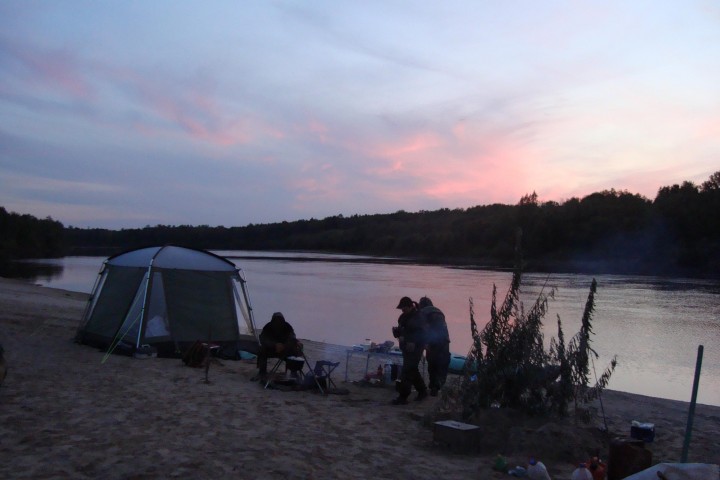
Road trips are good for talking, too. I found out that Pasha lived for a full two months in a forest much like the one we’ve been in. He was doing research on the biomass found in trunks, branches and needles of Siberian fir and Siberian spruce. I can’t imagine, myself, living in a forest camp that long, but then again, that’s what scientists sometimes have to do – and what they are lucky enough to do. Sometimes the forest is cold and wet and full of mosquitoes – but it’s sure a more interesting place than your average office.
Science is a pretty good profession for someone that likes to think, to travel, to question and be amazed, and to give something important back to the world as well. It’s a great community, one that fosters understanding among all people. I find it rewarding and comforting, as a senior scientist, to see the young faces on this expedition. These young Americans and Russians will continue the work that Slava and I have started well into the future, and will create their own studies. Our future here is in good hands.
As the miles went by, things got quiet, and I started thinking about the blog. If there was just one thing I’d like to get out to the readers – to students and scientists and policy makers and my family and friends, and, well – every one – what would it be?
After much thought, there’s one thing that keeps coming to mind. I do have one message today, for our readers. I want to tell them “Keep your wonder”.
Our world is an amazing place, with more depth, diversity and connection than can be imagined. If you look at this world with a true sense of wonder, then you will ask questions. From questions, comes study. And from study, comes answers – and more amazing discoveries.
With wonder as your guide, your “wow, that’s just amazing!” turns into “I wonder what makes that so amazing?” And then you can set about to learn about that wonderful thing. That’s science – learning about wonderful things. It’s just so important to not get lost in the minutiae and the business of life. It’s so easy to get swept up in the mundane. But that doesn’t have to happen. Keep your wonder, that’s all.
It’s time to get back in the car, and to drive on through the Siberian night. Hopefully we’ll be at our hotel by sunrise, and then enjoy a good day’s sleep.
Tomsk Oblast 58.55 N 85.68 E
11:00 p.m. Local Siberia; 11:00 a.m. next day EST
High 79 F Low 62 F Clear
We’ve been on the move today. Last night we looked at our data, and realized that we are done with last night’s site. We still need a day’s worth of different data, so that’s what we are doing today – chasing the data.
The site we are leaving was really productive. It was close to a lot of GLAS footprints, so we could get to a lot plots fairly quickly. And the team worked really hard to gather a tremendous amount of data in a short time. They would start early in the morning and come back late at night, pretty much exhausted. As a night cap, Ross and Bruce would look over maps and data and plan the next day’s work before bed. Pasha and Sergei were always working on logistics, keeping our camp and our instruments safe. So these guys have been putting in remarkable days here. But we have enough from that site – now we need something different.
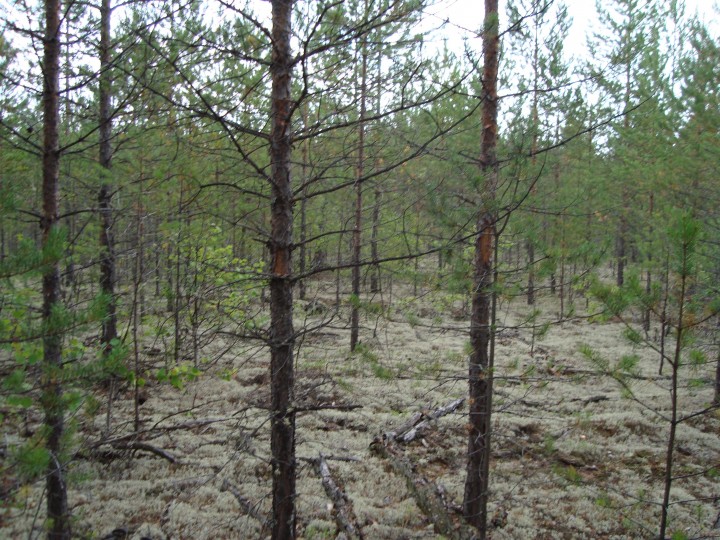
So what do we need?
Well, here’s some background. In order to help us to understand how our LIDAR waveforms – the data from the satellite – relate to biomass on the ground, we need to validate our instrument in three different types of biomass areas: high biomass, low biomass and “no” biomass. We need to know what our instrument is telling us in each area, not just in one or two.
High biomass areas are dense forests where most trees have a high DBH (diameter at breast height) and are tall, too. Low biomass areas are more sparse forest, with smaller and shorter trees. “No” biomass areas usually do have some vegetation, maybe even some small, very scattered trees, but are essentially just open land, with scrub or grass as primary vegetation.
On this trip, we’ve accumulated a lot of low biomass and some high biomass measurements. But we have not yet gathered no-biomass measurements, and we do want to have that from this area in Siberia. So that was our quest for today – to locate areas essentially empty of measurable trees. For that, we head to bogs.
Bogs are wetlands that accumulate acidic peat from dying plants, especially mosses or lichens. You don’t usually find a lot of trees in bogs, although some species can survive with their roots in water, or, as we like to say, with wet feet.
There are a lot of bogs in this part of Siberia. In fact, the western Siberian lowlands are the world’s largest bogs, covering more than 600,000 square kilometers. In parts of Russia, the bogs have been drained so that people can use the land for houses or agriculture, or to use the land for agriculture, or to allow dried bogs to be mined for peat. Peat is used commercially as soil amendment, in aquaculture, and as fuel. Russia is the world’s leading extractor of peat for fuel, producing something like 90 million metric tons a year.
But draining the peat bogs has set up a really bad situation. This summer western Russia is experiencing record high temperatures and drought, which led to huge numbers of wildfires. Forest fires are pretty bad, but dried peat bogs can be a nightmare when they burn – and they are burning. Peat fires release a lot of smoke and carbon dioxide, causing problems for health as well as the environment. Not only that, but it it’s hard to put out a peat fire. Dry peat is like a thirsty sponge, absorbing all the water that is put on it. Meanwhile, areas under the surface stay very dry. Subterranean fires can burn for weeks or months. Sometimes a peat fire will burn underground all winter, only to ignite as a wildfire again in the spring.
This area of Siberia, however, has had plenty of rain this year and only a few hot days. So our bogs are wet and easy to find. We drove about 50 km – without car trouble – and located just the right spot to get multiple “no biomass” measurements in a short time. Well, it wasn’t quite that easy. It took the team about three hours of extremely hard work to gather their measurements.
When Slava pulled over at our work site, we decided that, although the amoxicillin is working and I’m feeling better, bogs are no a place for a sick scientist. Slava and I stayed near the vehicles, while the team walked down a logging road. They said that the moment they turned into the forest, the walk turned wet, with mud grabbing at their feet.
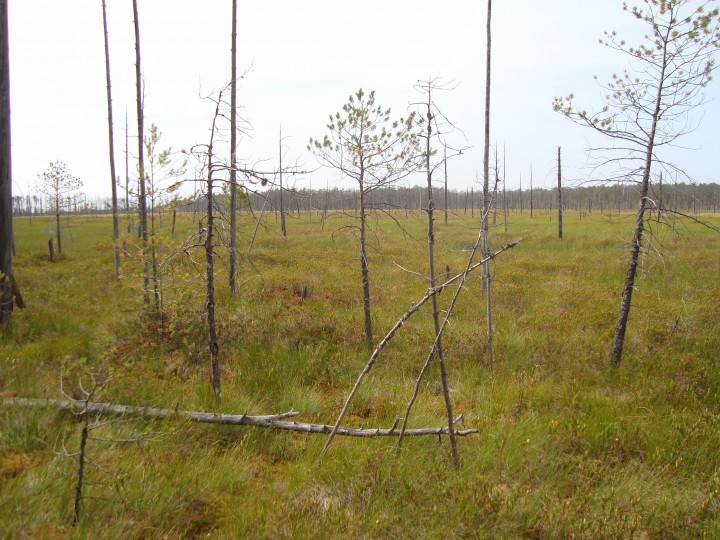
So why does it take so long to measure “no biomass” plots, if there is nothing to measure? Well, we’re here to verify the data the instrument gives us. Just because it indicates “no biomass” and we look across the horizon and see a bog, we can’t call that verification. It’s not science until you quantify it and measure it, objectively. So we measure no-biomass sites.
Just like anywhere else, we find the center of the GLAS footprint, and lay out our 10 m radius plot. Then we need to walk the area to make sure there is nothing of measurable size within that circle. Sometimes there may be some small stuff that needs notated or measured. And we need to make some field observations about the type of soil and ground cover. But most of all, we need to get to the center and lay out our plot. And, in a bog, just doing that can be very tiring.
I can’t remember exactly how many sites they measured today, but I know we have over 60 plots total for this trip. That is enough, and it’s amazing work for a trip that has had so many delays. If you remember, we arrived in Krasnoyarsk late, because of the fires that shut down flights through Moscow, and that took two days off our field study. Then we had delays to repair the car and a long side-track because the road to Belyy Yar was impassible. And we were short one set of hands, because I’ve been sick. Yet we’ve overcome all of this, and still gotten enough plots to make our analyses back in the lab. I cannot say enough about the hard work and good humor of these guys – Pasha, Sergei, Ross, Bruce, and Marsha – they are a tough and awesome crew.
After everyone came back from the bogs, we stowed our gear and headed off to find a camp. And we found a nice one, once again on the Ket River. The sand here is white and very fine, so it is different from the tan sand we slept on at Camp Stepanova. Slava looked at the sand closely, and he says it might reflect that this area was either an ocean or a desert at some time long past.
This area was once used as another sort of camp, and it’s been well-used. Someone heavily worked the sand and grass with a bulldozer in the past, so it’s very flat. We are right on the river, and the breeze is cool, but it keeps the mosquitoes down. It is a good camp – no roots or rocks to disturb sleep, just warm sand.
We are still missing our fish soup. Not long after we got here this evening, Sergei set up the inflatable boat and put some nets in the river, hoping to get some supper. But he caught nothing. We couldn’t catch anything with rod and reel, either. They say there are big pike in the Ket – if we could just wait until the full moon when they are wearing new teeth are new and get very hungry. In a way, I wish that we could just hang out until the full moon, but in another way, I am ready to head for home.
Stepanova, Siberia 58.67 N 86.76 E
11:05 pm Siberia local; 12:05 pm next day EST
High 74 F Low 52 F Scattered Rain
Once again I’ve had to spend a day in camp. I have gotten so frustrated and disgusted with being sick, that I’ve gone to the medical kit and started taking amoxicillin. I’ve had two doses and three days of rest, and I am feeling better. But not quite fit enough to tromp around the woods. Not yet. I’m sure I will be back in the field very soon.
I had a great plan to make myself useful in camp. When we go to the field, we measure all the trees that are over 6 cm in diameter. But we also need to estimate the biomass of the smaller trees. We have some ways to estimate that, but I thought that since I was hanging around, that I could use a protocol to get actual measurements of local biomass of the small sizes.
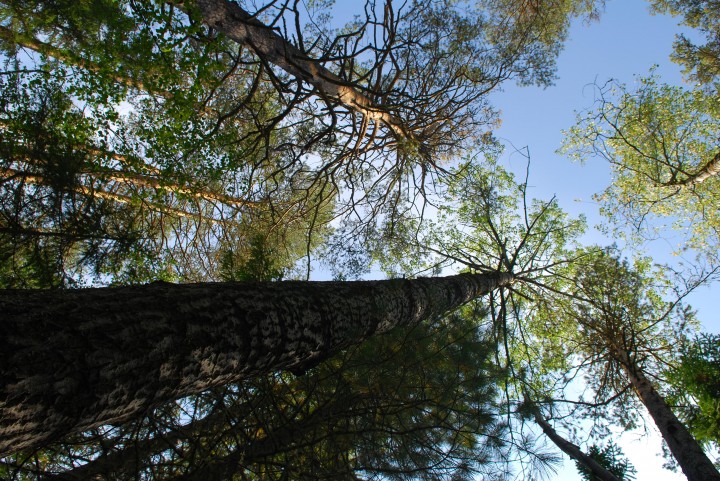
To do this, one goes and cuts down up to 30 small trees of each diameter class. That would be 0-2 cm, 2-4 cm, and 4-6 cm. Then we tie them together and weigh them. This can be important, because some trees are not very dense and have a relatively low biomass to those which grown more densely. Lower density means a lower weight. There are ways to estimate this, but actual measurements are most helpful. My plan was well received by everyone, and I looked forward to being useful.
There was just one small little problem, however. We did not bring a scale. Slava went into town, but couldn’t find a scale anywhere. There was no way to go forward with these measurements. So it was another day of rest.
Today the guys on the motorcycle were back, and they were more talkative. They said that they had good luck catching a carp-like fish on the far side of the river. That’s the same fish that Slava had brought back from the store a few days ago. Now we know where our meal began – this very river!
They also said that we would not catch much pike right now. They are changing their teeth, they said, and pike will not bite when they do that. They said that by the full moon they will have all new teeth, and they will be very hungry and then we can catch very big pike from the Ket.
I had never heard of such a thing – pike changing teeth. I’ve checked around and it seems to be true. Northern Pike do shed their teeth, but they don’t usually do it all at one time. They tend to shed old teeth and grow new ones around the peak fishing season, when the water is warmest, which usually occurs sometime in August. When they are shedding, their old teeth start to fall out and their mouth develops small swellings where the new teeth are erupting. Their mouths are sore, so they don’t like to bite.
I also learned that pike are adapted to very cold water and are quite sensitive to temperature change. As water temperature increases, the tooth-shedding cycle becomes more rapid. They also respond to warm temperatures by refusing to eat – regardless of the state of their teeth. Russia has had a very hot summer, which has warmed up some lakes and rivers. I wonder if it is more the teeth, or the warmth, that is bothering our pike?
When the crew returned from the field, they had completed 16 plots. They said the forest was extremely dense, and again they had a lot of very large aspen. Marsha said that some of the plots were in forest that had never been visited before by anyone. They were extremely difficult to reach, with no sign of any human intervention – a true rarity in our experience here. But our satellites have been there – at least overhead – and we have the data to prove it. It was fabulous that they could get in the area and get those measurements.
I should explain that we have GLAS footprints from many overflights of the ICESat satellite. ICESat stands for Ice, Cloud and land Elevation Satellite. It was a mission for measuring ice sheet mass, cloud and aerosol heights as well as vegetation and land topography. It flew from 2003 until the instruments shut down in early 2010. It flew the GLAS instrument, or the Geoscience Laser Altimeter System, which was a LIDAR (LIght Detection And Ranging) system. LIDAR measures properties of scattered light to collect various information about a distant target. It is this data, in waveform, that we use to understand the forest.
During its flight, ICESat passed over the same area about every 91 days, measuring 70 m footprints about 170 m apart. In this area, we have multiple tracks over multiple years. Most of the measurements were taken in the 2003 – 2008 range, and that creates a little bit of a problem, because it is now 2010. The forests have changed since the measurements were taken, some more than others. We have mathematical formulas to correct for anticipated forest change over the years, so today’s data is still valuable for us, even on 2003 data.
Right now, there are still satellites that are measuring these forests. There are instruments like Landsat, built to view the world’s landscape, and MODIS, the Moderate Resolution Imaging System, flying. These give us a two-dimensional view of the vegetation. However, in order to accurately measure biomass, we really need to be able to see the third dimension – height. Right now, there is no viable instrument that will do that for us. We need one, very badly, in order to gather crucial information on biomass that is so important for decision making.
We are working to create new and better instruments. They will be put aboard DenDynI, the Deformation, Ecosystem, Structure and Dynamics of Ice satellite. It will have five times as many beams as ICESat, and, if it is built as planned, will give a more accurate measurement of the forest that ICESat could do. It is supposed to fly in 2016. Every measurement we make in this forest will be used to analyze data to create new, more accurate algorithms, so that the instruments on DesDynI will be the best possible. They will take us to the third dimension, accurately measuring the height of vegetation from space.
Height is the missing piece for biomass studies. With the other instruments, you get enough data to make a very gross estimate of forest biomass, but without a height measurement, it can only be a guess. It can’t be accurate. We hope with a better instrument, we will be able to close the carbon budget.
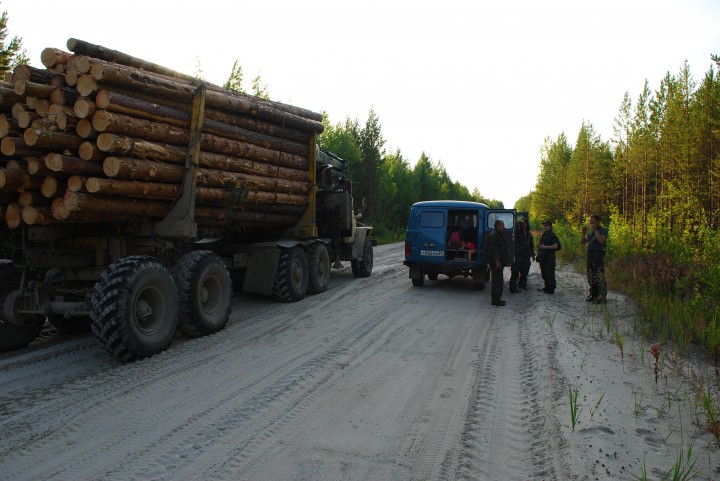
What do I mean by that? Well, we know there is only so much carbon in the world. We have a pretty good idea of atmospheric carbon. We also have a pretty good idea of how much is taken up by the ocean. We can measure how much carbon people put into the atmosphere from burning fossil fuels and other things. But what we don’t know is how much carbon is put into the atmosphere from land cover change, such as burning or logging. We also do not know how much is taken up by the vegetative biome. Plants use photosynthesis to absorb carbon and sequester it, and that is a good thing for keeping climate steady. By getting accurate measurements of the biomass of the forest, we can begin to get a realistic view of the carbon stored here.
So that’s the carbon budget – the amount of carbon going into the atmosphere should be balanced with the amount stored. The thing is, we don’t know the storage capacity of the vegetation, especially the forests. That’s what we need to know.
Closing the carbon budget will allow for sound policy decisions. The world’s forests are a powerful provider of carbon sequestration. They remove carbon from the atmosphere, storing it in roots and trunks. We know people release a lot of carbon. If you can manage the forests well, then they can take up this carbon; the forests can keep the balance. Policy makers don’t need a way to figure out how to get rid of the excess carbon we are producing, such as storing it in the ocean, as has been discussed. All we need to do is to manage the forests, and they will absorb the excess carbon for us.
But one can’t manage the forests or manage the carbon budget without accurate information. So that’s where science comes in – we need good instruments and we need accurate data. That’s why better instruments are so important, and why we are here, working so hard. It’s a job worth doing, I think.
Stepanova, Siberia 58.67 N 86.76 E
10:35 pm Siberia local; 11:35 pm next day EST
High 74 F Low 52 F Scattered rain
It has been another day in camp for me. I am feelin a little better, but my head is still stopped up and that makes it hard to exert myself. I don’t think I’m all that sick, really. If I was going to the office, no problem. But here, in the Siberian forest, everything requires a huge physical effort. And when you’re sick, even walking fifty yards is an effort all by itself. Expeditions and colds just don’t mix.
They did a great job today, as usual. Pasha, Ross, Sergei, Bruce and Marsha spent a long day in the forest, and came back with 16 plots measured. That’s a great day’s work. They report that the sites were fairly dry and the dominant species was Scots Pine. I hear that there are some amazing Aspen – some at least 100 years old. I have to say that this crew works really hard, and they work extremely well together. Everyone is tired, but in a good mood. Thanks to them, this expedition is making up for lost time.
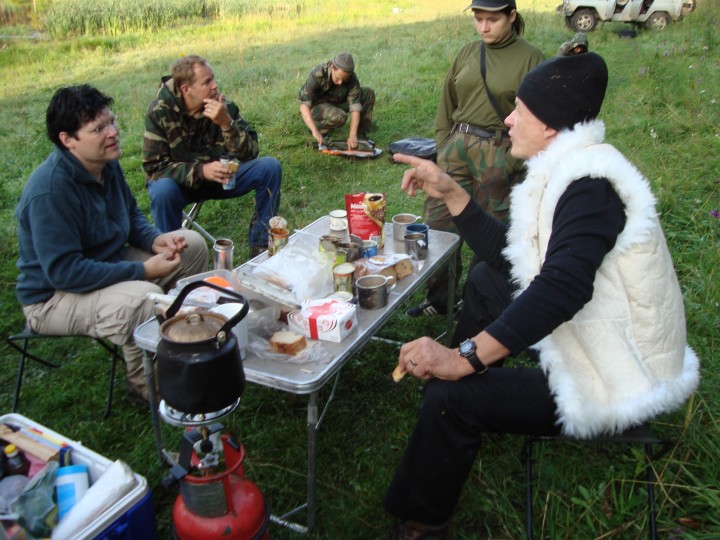
When the body won’t work, the mind can still think. I’ve spent the day thinking about the importance of expeditions like these. It costs a lot of money to get everyone here. It takes everyone away from our lives and their families. And it’s really hard work. We don’t come here for fun. Yes, we enjoy ourselves when we can, but, at the heart of it, this is very serious business and hard business, too.
So I was thinking today about all the sacrifices we make to get out here, a half of a world away from home, just to make these measurements in the forest. I was wondering if it was worth it all. And the answer is unequivocal: yes.
Sometimes scientists and policy makers sit in their comfortable offices, looking at data from our remote-sensing instruments, and thinking that’s really all we need. Sometimes it slips our mind that people are living in these forests, and relying on them for their own lives. And sometimes we forget that there is a lot more knowledge on the Earth than can be gathered remotely. It is only by getting into the forests and getting onto the land that we connect with reality. And we need to talk to people, too. People that live with the land – like the Siberians we’ve met, have an incredible amount of knowledge about the forest. They have a lot to share with us. And they are greatly affected by forest policy as well, so our data can impact their lives.
The Siberians we’ve met are helpful, friendly people. They give us gifts, offer us hospitality, give us directions and are quick to laugh with us. We all are here in this forest at this time for our own reasons. But in the end, we’re really all just trying to do what is the most important to us – take care of our own lives, take care of our families and take the best care we can of our forests and our Earth. While they live day-to-day within this forest, we are trying to understand this same environment, to keep it healthy and viable, long term.
So as different as we are, we are connected through this forest. A few days ago I felt very connected to the past, as we worked forests that the kulaks had worked. Yesterday we connected with the past again as the harvesters cut the grass by hand, just as Slava’s grandfather had done, and generations before him. Today I realize that the forest doesn’t just connect us to the past, it connects those who live a half a world away, in the present, despite our very different lives.
The forest connects us to the future, too. It is here, in the forest, where carbon is taken up at a high rate, and that may be a key to living on this earth without destroying it – to care for the carbon sequestration to keep the earth in balance. Caring for the forest is, in a very real way, caring for our future.
Sometimes the forest is called “the lungs of the world” –and in a way that is true. The forest is a living entity, one which helps keep our Earth clean and temperate through its very existence. If we can use our data to learn more about this forest, and to help policy makers make decisions to better manage this essential part of life as we know it, then we are making a real contribution to the health of our future.
This expedition is allowing us to study very different forests than we saw in 2007 and 2008. We were in extremely remote areas then. The forests were in a more natural state, so we were studying mainly natural changes and climate changes, with less direct influence from humans. Here the forests are heavily used by people. We can study the effects of human influence on the forest. As someone said in camp today – in years past, we were in the middle of nowhere. Now we are just on the edge. It’s a different world, and we are learning a great deal about human-forest interaction.
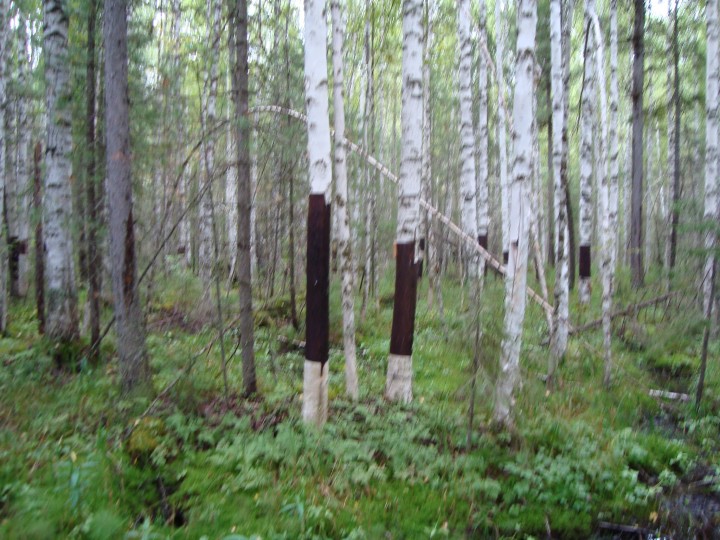
There was some excitement in camp this morning. Two men arrived on a little motorcycle with a wooden sidecar. In the sidecar was an inflatable boat. They blew it up, carried it to the river, went to the other side, and started fishing. They were pretty quiet about it all, and didn’t chat with us. I guess they were catching something, but we couldn’t see what.
So we decided we’d better go see what they were catching. We haven’t caught any fish at all this trip, which means there has been no fish soup. That was a staple in prior expeditions, so we’d like to have at least a taste this year. To make fish soup, one takes a whole fish, chops it up, and throws it in a pot with onions and seasonings. That’s dinner. In years past, it was also sometimes breakfast and lunch, too. This year, we’ve missed the key ingredient: fresh fish.
Whatever the success on the other side of the river, we had no luck here. The only thing I caught was a six-inch Northern Pike. Might sound like something, but pike are so skinny that it looked like a cigar. He was cute, but not big enough to flavor soup, so I let him go. Slava shook his head, saying he’d just go tell his buddies that we were here trying to catch them, and we’d get no more fish today. And that is exactly how it worked out – one cigar, and no more.
I heard that there was a little misunderstanding on the way back from the forest. The crew decided to stop at a store to get some supplies. Bruce had bought some bottled water in Tomsk, and wanted more. I think it’s called Bon Aqua. He went into this little shop, showed the keeper the bottle, and lifted his finger up in “one” sign, hoping she would sell him one bottle of Bon Aqua. After a moment, she smiled and graciously took the bottle from him, went to the tap, and filled it up. Bruce called the Russian-speakers over to help, but it was just no good. Not only was there no bottled water, but the shopkeeper just could not imagine why anyone in their right mind would want to buy water, when the best water in the world was to be found, free, in Stepanova. Apparently, the town is world-famous for mineral springs and healing water. I guess we are the talk of the town tonight, as those folks who came to the best water in the world, and wouldn’t drink.
Well, if it’s healing water, I’ll be drinking it. We’re going to stay here for at least one more day and night. There are many GLAS footprints nearby, and it’s most efficient to stay put, without wasting more time on rough road. Between the rest and the mineral water, maybe I’ll be fit to work tomorrow.